Who Is Adi Hütter?
After seven games of the 2024/25 Ligue 1 season, Monaco are top of the table with 19 points, two points ahead of second-placed Paris Saint-Germain.
They’ve conceded just four goals at this stage in the campaign, the second-lowest total in all of Ligue 1 and two lower than their nearest rivals for the title at this point in the season — PSG.
Last season, in his first as manager of the club, Adi Hütter tactics guided Monaco to a second-place finish, ending the campaign nine points behind Les Parisiens.
Their last seven games of the 2023/24 campaign saw them keep five clean sheets and concede four goals—very similar to their first seven games of this season.
It’s clear that Hütter, who won the Austrian Bundesliga title in 2014/15 with Red Bull Salzburg and the Swiss Super League title in 2017/18 with Young Boys before going on to manage Eintracht Frankfurt (2018-2021) and Borussia Mönchengladbach (2021-2022) in the German Bundesliga, has placed a great emphasis on shoring up his team’s defence ever since making the move to Ligue 1 just over a year ago.
Thus far, his efforts have been highly successful.
But what exactly are Hütter’s flourishing defensive tactics with Les Monégasques?
This tactical analysis and team-focused scout report aims to provide some in-depth analysis of Hütter’s out-of-possession approach with Monaco, mainly centring on their masterful use of blind side pressure.
Wide Pressing Traps
While their general shape will usually vary along with specific tactics from game to game and opponent to opponent, a team’s strategic principles will largely remain a consistent blueprint that is filled in by the tactics and roles that a given match demands.
In Monaco’s case, they’ve slightly favoured the 4-2-3-1 shape this term, though the 4-4-2 and 3-4-3 have also made appearances.
Indeed, they’ve been flexible in terms of their shape based on the demands of particular matches.
Still, their strategy has been consistent in that Hütter’s style of play requires them to be an energetic, fast-paced, aggressive, pressing unit that tries to get at the opposition right from their build-up play.
Their adherence to these principles has made them statistically the most aggressive pressing side in Ligue 1 at this point in the campaign, with the lowest PPDA (7.55) and highest challenge intensity (6.7) of any side.
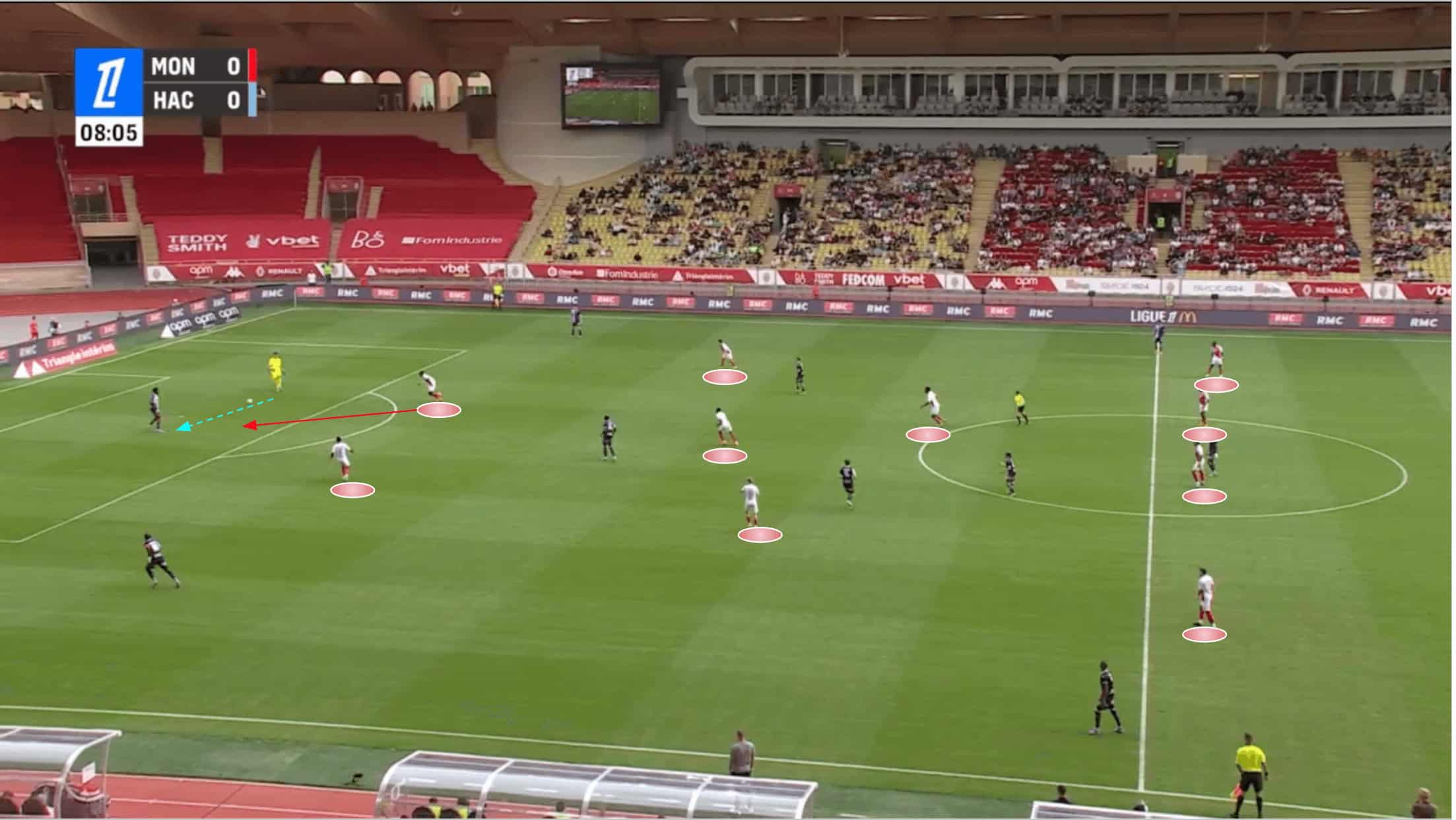
Using the 4-4-2 shape against Montpellier, we see Monaco pressing the opposition right from their build-up.
At this point, Monaco’s shape is positioned quite centrally.
The opposition are still in possession of the ball deep but in the middle of the pitch, and they may move the ball out to either the left or the right.
Monaco tend to be very horizontally compact in terms of their spacing and shape, which results in the wingers and full-backs tucking in very narrowly.
Similarly, their central midfielders will actively position themselves on different points of the midfield line in relation to their verticality, ensuring big gaps don’t open up between the midfield line and either the forward or defensive lines.
All of these defensive principles effectively ensure Monaco can control the middle of the park, which is the most valuable part of the pitch for any team.
If you can control the middle of the pitch, you have a good chance of winning the game, thanks to the value of those central areas in terms of chance creation.
This is why Monaco will position their wingers relatively narrow, sacrificing space out wide at first in order to ensure the centre remains compact.
However, as the ball moves wide, Monaco will move to the next phase of their press, which congests the space out on the wing.
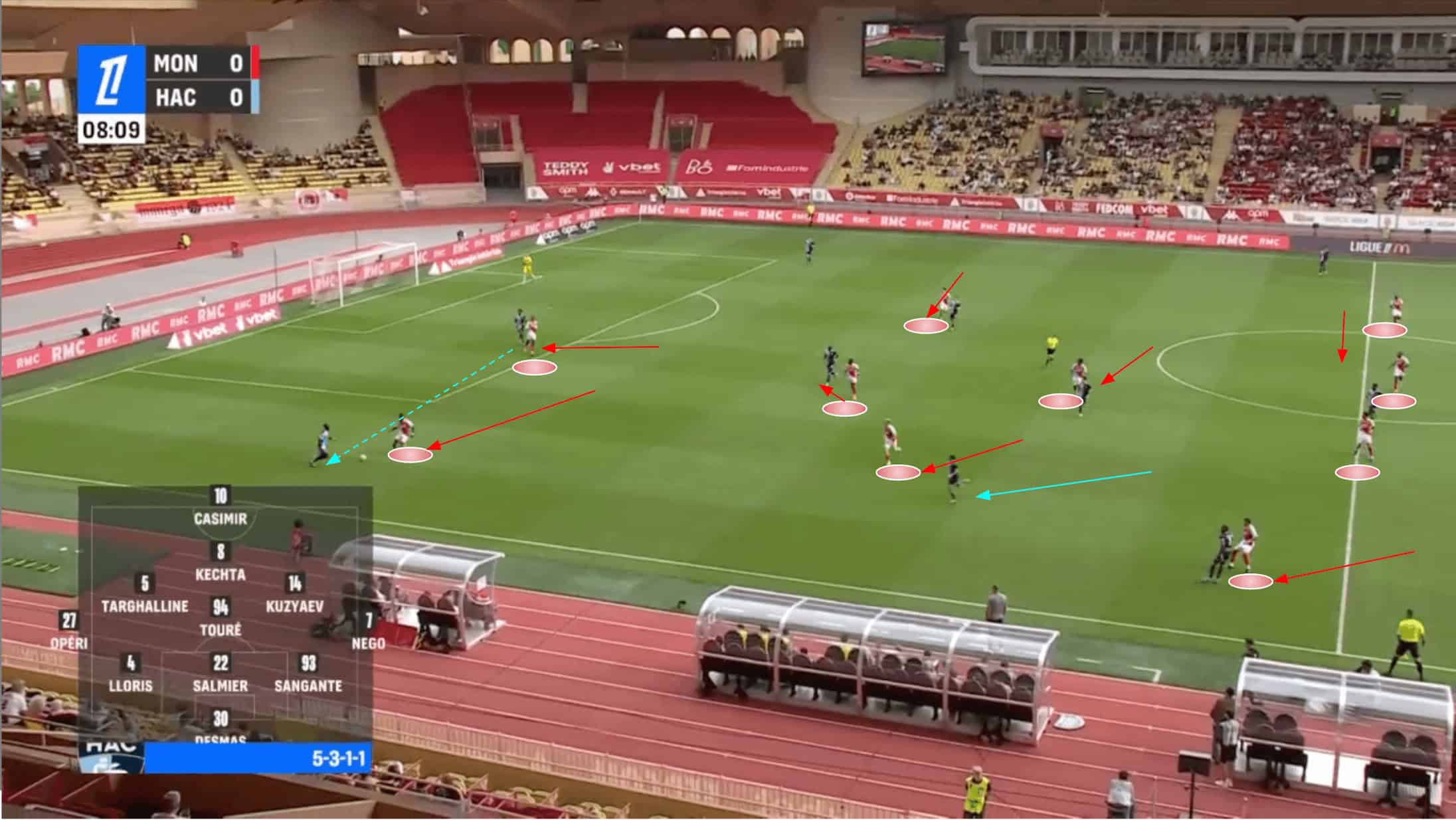
As Montpellier find their wide centre-back on the right, Monaco’s right forward stays close to the central centre-back, denying Montpellier the simple pass back across goal.
The left forward closes down the ball carrier while strategically keeping the pass into the midfield in his cover shadow, denying that option, which is also being closely marked by one of the central midfielders.
The rest of the midfield, now looking like a diamond, also shifts over to this side of the pitch, offering support to the first line of pressure.
This is an example of one of Hütter’s most common pressing traps — the wide pressing trap in the high block phase.
When this trap is triggered, Monaco’s midfield becomes very man-oriented in relation to the opponent’s passing options near the ball carrier.
The shape as a whole remains ball-oriented and shifts over to congest the space around the ball while ignoring the players on the opposite side, leaving them open for a possible switch of play.
This strategy is evident in how Monaco’s left-back — the full-back on the ball side — gets very close to his winger while the right-back forgets about his winger, instead tucking in and shifting over along with the centre-backs.
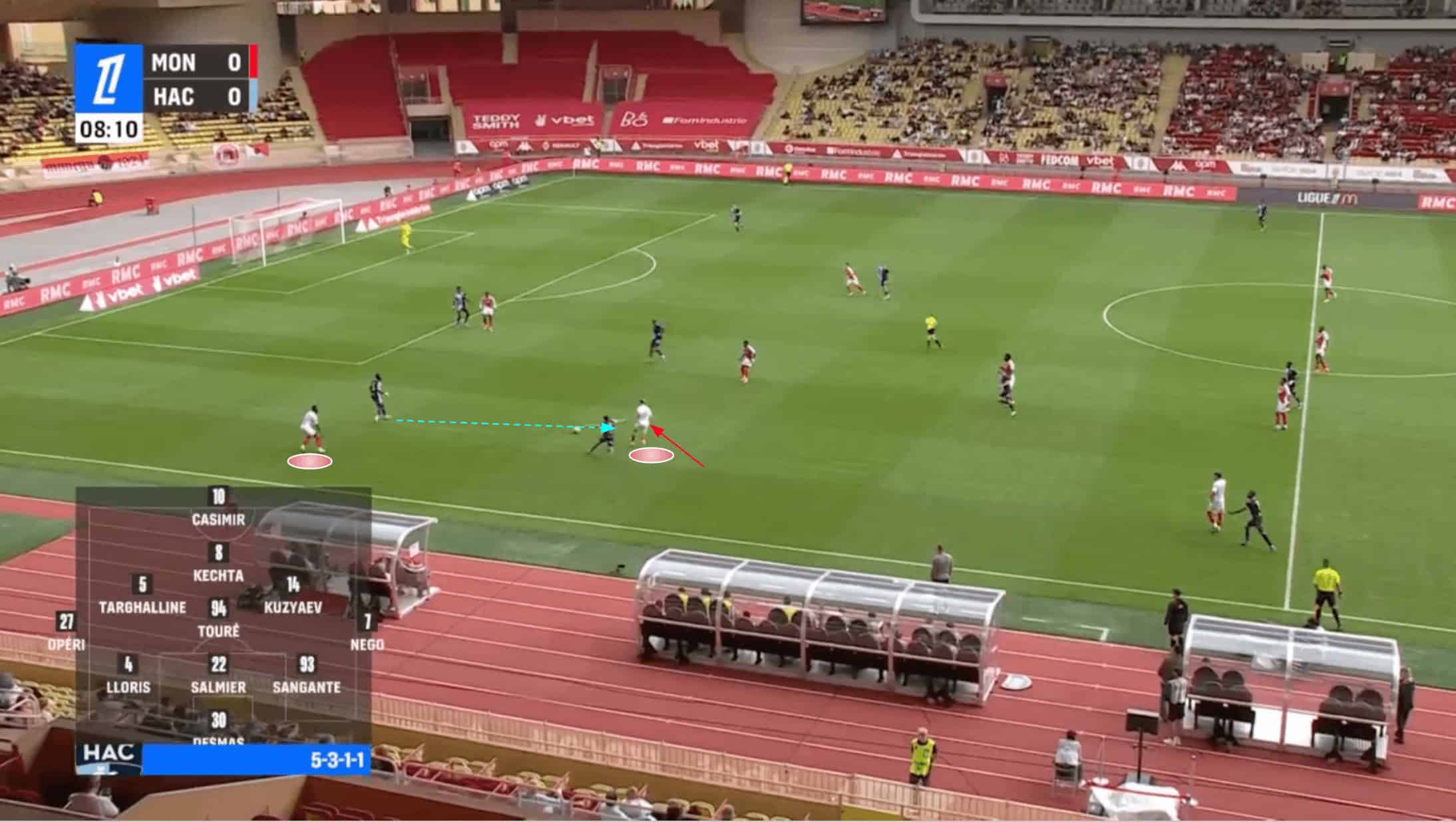
As play moves on, the ball carrier succumbs to the immense pressure being applied.
The passer plays a rushed and inaccurate ball into the nearest central midfielder, which is easily intercepted by his man marker in red and white.
This passage of play highlights the effectiveness of one of Monaco’s most common pressing traps this season.
It has enabled the side to make high regains this term and shut down opposition attacks early before they can develop into something threatening.
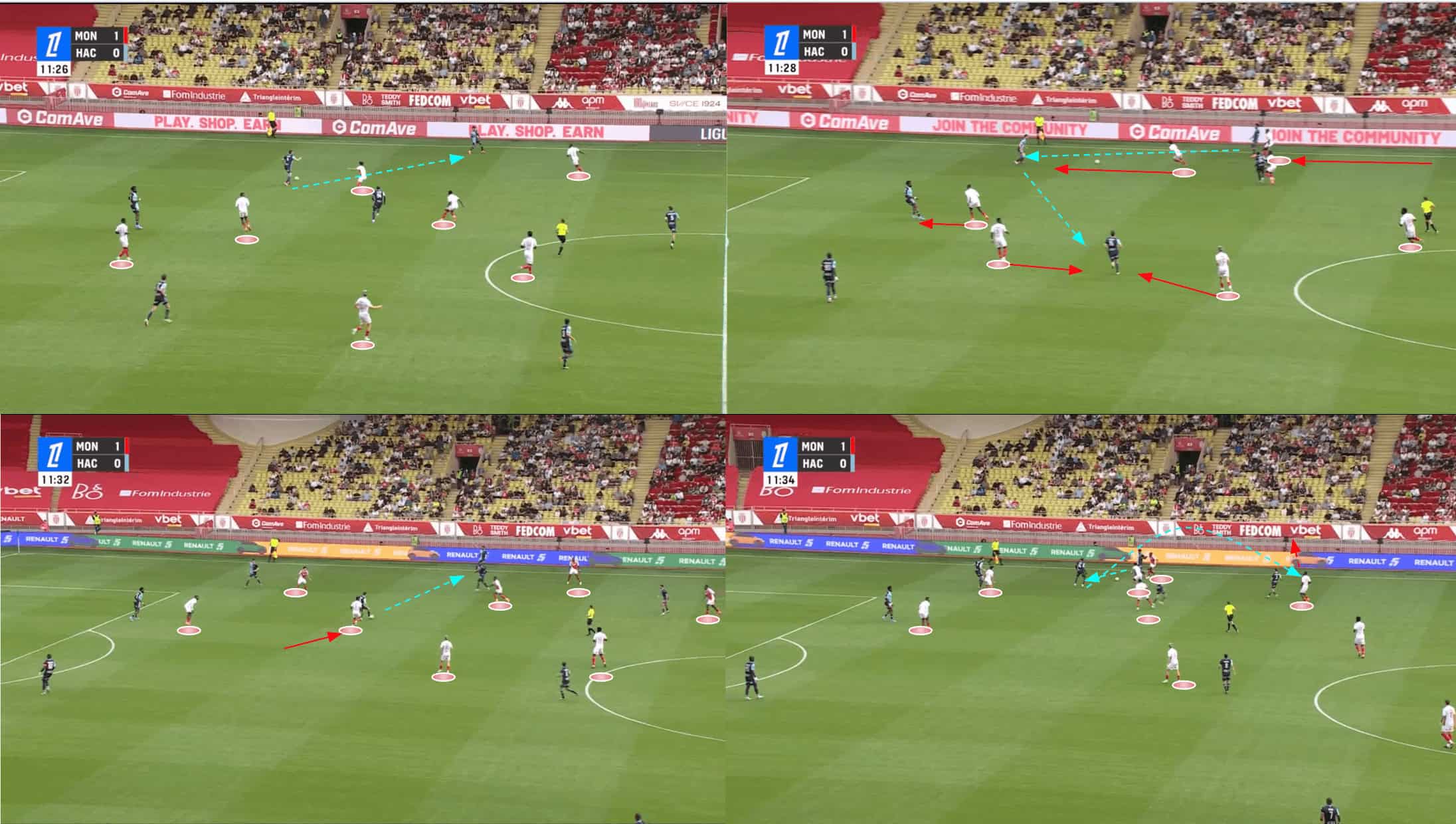
In Figure 4, we see Monaco yet again trapping the opponent out wide during their build-up play.
In this example, we join the play with Monaco already congesting the space around the opponent while they’re in possession on the left.
Again, the strikers’ positioning is crucial as they come across and cut off the simple passing routes across goal for the opposition.
As Le Havre play the ball out to the left-back, he’s pressed aggressively from behind by Monaco’s advanced right-back.
Blindside pressing is another standard part of Monaco’s pressing strategy under Adi Hütter’s coaching style.
It has many benefits, which we’ll discuss in greater detail later.
In a nutshell, blind side pressing has several benefits, including the fact that the receiver may be unaware of the defender coming from behind and, as a result, proceed as if they have time and space to turn, thus potentially running into a proverbial wall.
Just as effective is the fact that the opponent in possession may be aware of the defender coming from behind, especially if teammates make him aware of the fact verbally; still, they’re hindered as now, as was the case in the top-right of Figure 4, his options for the next action are severely limited.
In this case, the opponent was forced to play the ball backwards but did manage to find someone positioned more centrally, which was not a bad option based on what Monaco had left available due to the intensity of their congestion of space around the ball carrier out wide.
The next receiver was also pressed from the blind side with similar results — hindered movement and a less-than-ideal following action from the receiver, who moved the ball back out to the crowded wing.
This attack sees a couple more passes made before the opponent hits it long, attempting to go over Monaco’s press rather than through or around, resulting in a throw-in.
This wasn’t a perfect example of Monaco’s wide-pressing trap.
Still, it does highlight a few of their defensive principles working in tandem — increased pressing intensity out on the wing, a ball-oriented pressing shape in the high block and blind side pressing when possible.
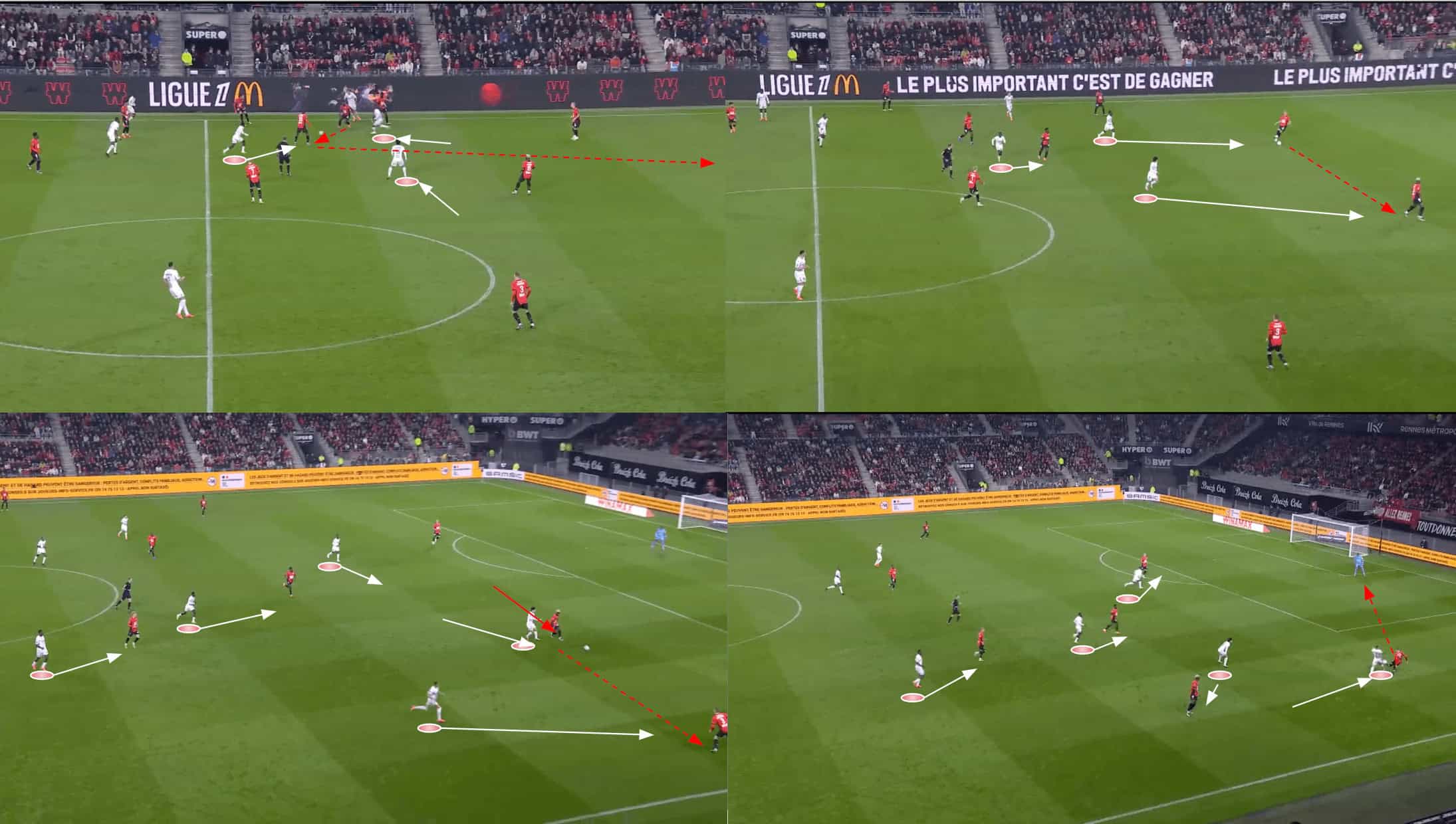
As mentioned in figures 1-3, Monaco’s pressing strategy naturally leaves space open on the ball-far side for the opponent to potentially exploit.
Usually, the pressing intensity is so high around the ball that the prospect of switching play is fairly impossible, especially as the simple passes across the pitch are usually marked out of the game by Monaco’s well-organised press.
However, the switch can be made, with Figure 5 providing one example of how Rennes managed to get the ball over to the left after starting on the right in both sides’ most recent Ligue 1 game.
The movement across the pitch begins when a receiver on the crowded right side is pressed from the blind side by a Monaco midfielder, forcing him backwards.
Monaco continue energetically and persistently applying pressure to Rennes’ receivers and their nearby forward passing options as they move the ball across goal, as highlighted above, before finally reaching the left-back.
When he receives the ball, he’s immediately under intense pressure and is left with no option but to play it back to the goalkeeper.
This passage of play emphasises the importance of Monaco’s organisation, adherence to Hütter’s pressing principles, and, crucially, fitness for the success of these defensive tactics.
Hütter’s tactics are well thought out and clearly effective, but they can’t succeed as they do without the players’ fitness levels being at a really high level, as seen in the above example where a lot of sprinting was required from the forward and midfield lines.
Some of the credit for Les Monégasques’ success in pressing so far this term has to go to the team’s fitness coaches as much as it goes to the tacticians involved in the strategic planning.
At present, Monaco are looking like one of the fittest teams in France’s top flight; if they can maintain those levels while implementing these tactics over the coming weeks, with both domestic and European football to contend with, while avoiding many injuries, they’ll continue to be a very difficult side to contend with, but that is, of course, easier said than done.
Blind Side Pressing Vs Barcelona
We’ve already discussed some of the overall pros of blind side pressing and seen some examples of how Monaco have applied it in their domestic games against Rennes and Le Havre above.
However, the benefits of these tactics were perhaps never more evident than when Monaco applied their blindside pressing strategy against Barcelona in their 2-1 UEFA Champions League win on September 19th.

Figure 6 shows two examples of Monaco forcing Barcelona back from the midfield to the backline in quick succession.
The top two images show Barcelona trying to play through Marc Casadó and being forced back, while the bottom two show left-winger Raphinha dropping into midfield to try and help the team get past Monaco’s mid-block, only to again be casually forced backwards by blindside pressing and good marking from the red and white shirts around the ball which cut off any other nearby passing options.
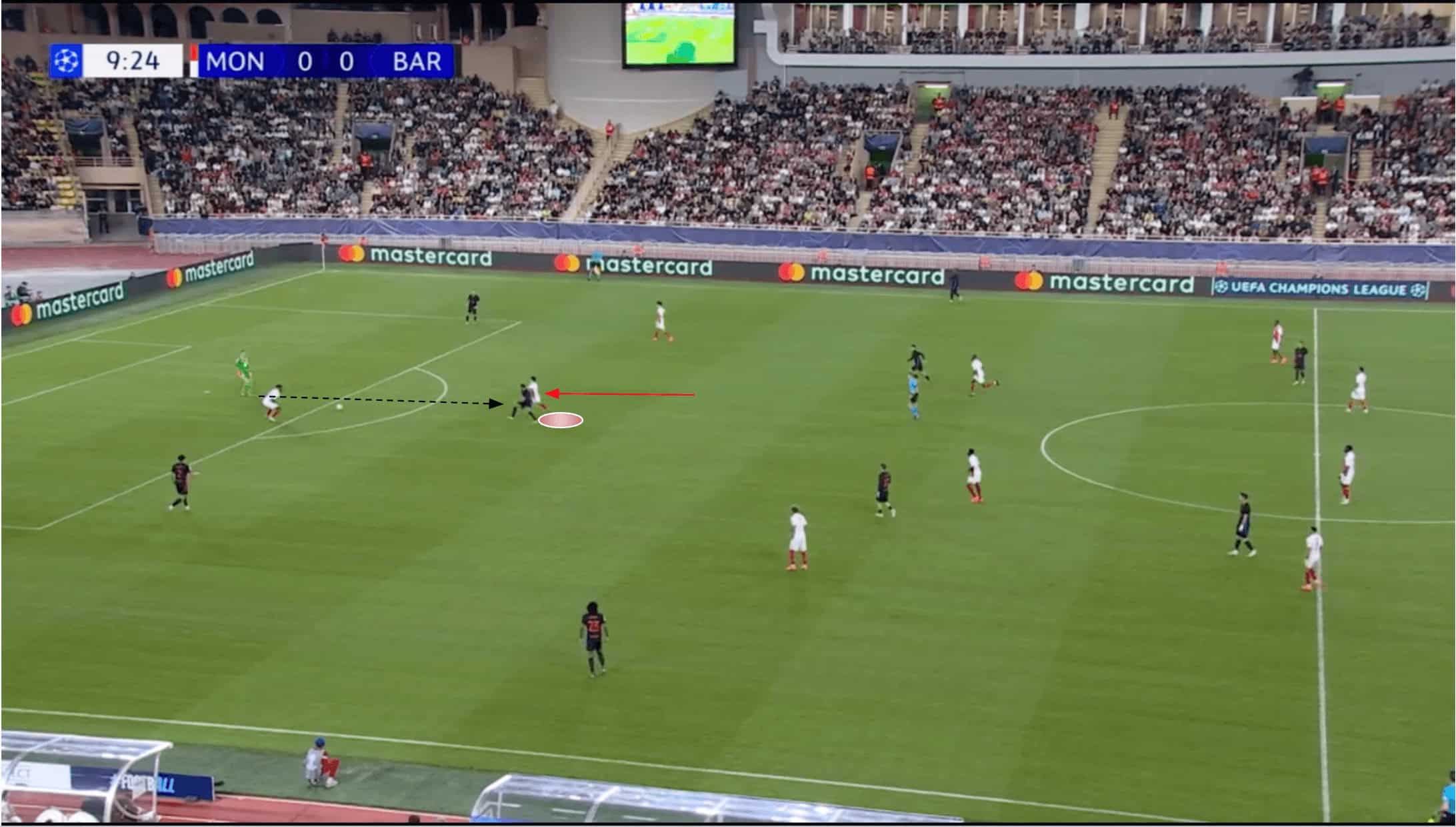
Monaco got a numerical advantage early on in their UCL clash with Barca, as Eric García was sent off in the 10th minute for a foul on Takumi Minamino.
Les Monégasques weren’t purely lucky to be handed the advantage, however, as this foul occurred as a result of blindside pressure on García in the build-up from Minamino.
We see the pass coming towards García from the goalkeeper in Figure 7 above while Minamino aggressively closes in from behind, making ‘keeper Marc-André ter Stegen immediately regret his decision.
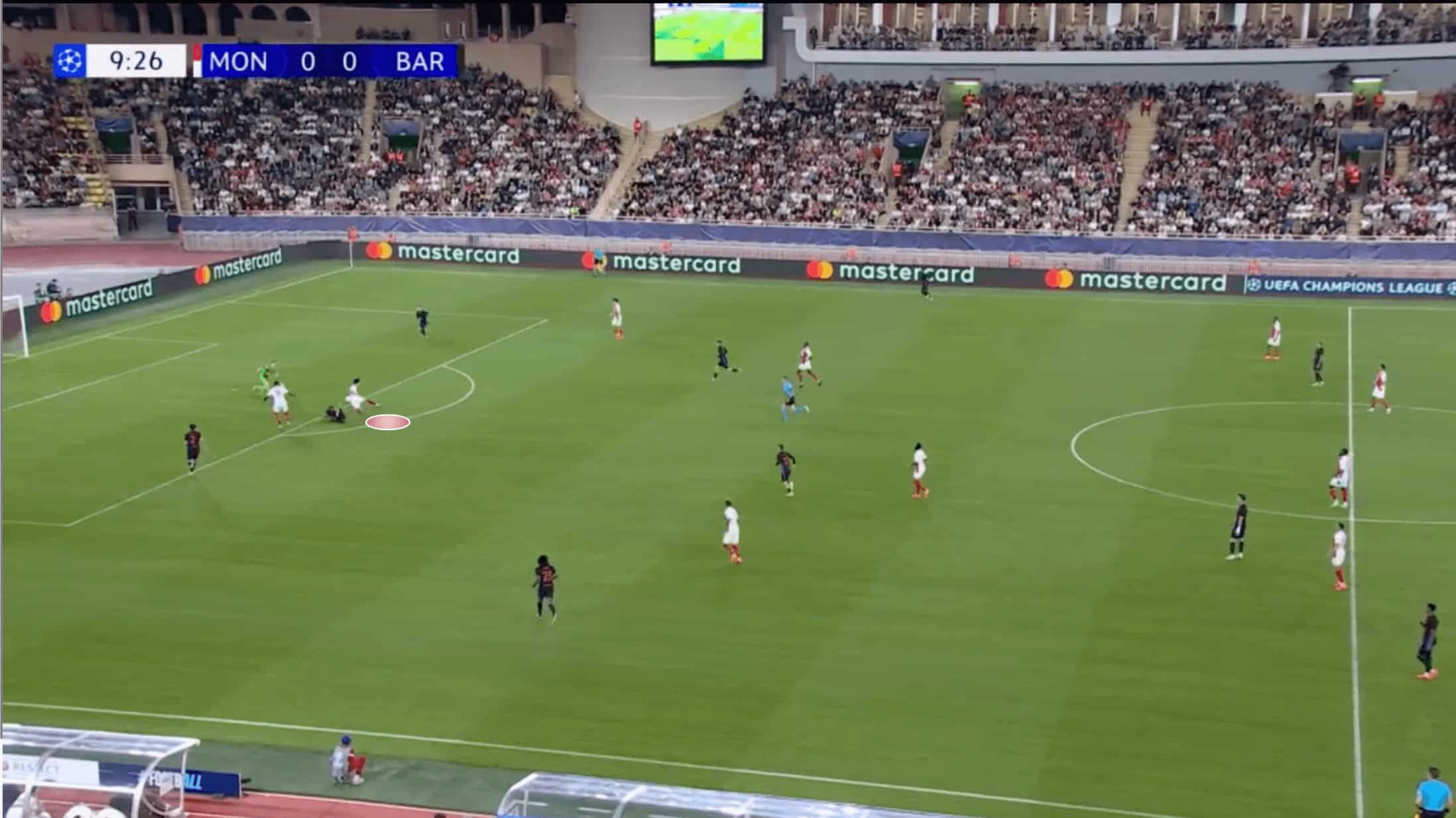
Minamino manages to nip in front of García and take the ball away in a dangerous position, prompting García to foul the Japanese playmaker on the edge of the box, resulting in a red card.
Again, this passage of play highlights how Monaco’s aggressive pressure can lead to high turnovers and the benefits of their blind side pressing approach, which was perhaps the key catalyst in their victory over Barcelona.

Shortly after Minamino’s high interception on García, Monaco forced another high turnover as a result of blindside pressure against a frustrated and flustered Barca side.
Left-holding midfielder Lamine Camara can be seen approaching intended receiver Casadó from behind as left centre-back Iñigo Martínez aims his pass towards the holding midfielder.

As discussed previously, blind side pressure limits the receiver’s movement and, as a result, his following action.
In this case, Casadó was prevented from turning, resulting in a sideways pass towards his midfield partner, with Minamino and Breel Embolo blocking potential passes to the centre-backs in Monaco’s intelligent pressing trap.

The pass ends up getting intercepted by Maghnes Akliouche, who was marking this midfielder very closely and can now begin the counterattack for Les Monégasques.
This game provided an excellent showcase for Monaco’s pressing quality, particularly the benefits of their blindside pressing.
This pressing has been a crucial aspect of their defensive tactics and, indeed, offensive tactics through the high turnovers it generates repeatedly.
Tracking Back
Our third section of this tactical analysis will focus on Monaco when they’re forced to defend deep and in defensive transitions.
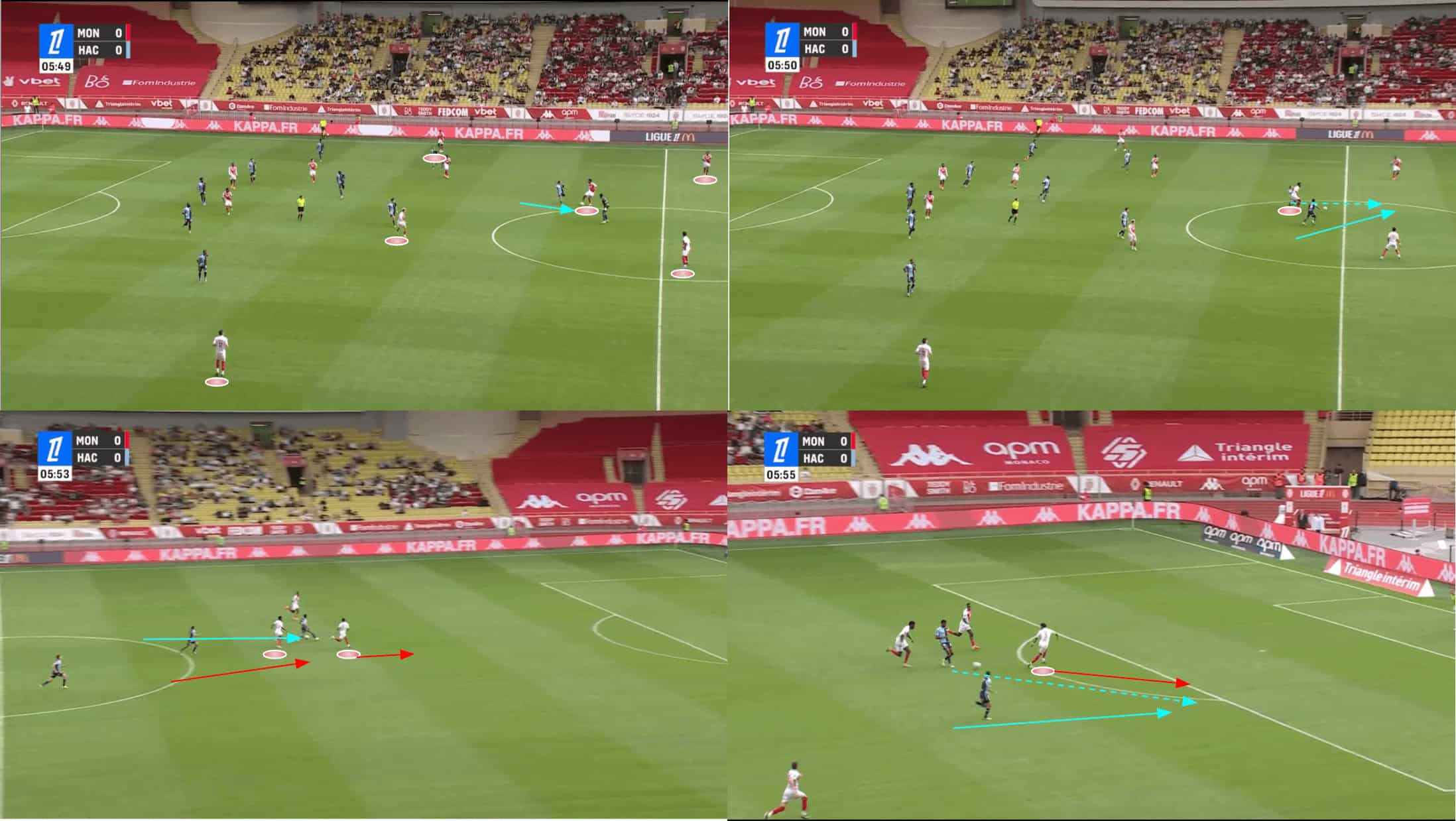
Monaco like to send their full-backs high and wide in possession, which can leave their centre-backs a bit isolated if they get caught in possession in midfield or give the ball away in the progression phase, resulting in an opposition counterattack.
This is a major weakness in their game, which has led to chances and goals conceded in 2024/25.
Above, we see an instance of their holding midfielder being dispossessed by opposition pressure, forcing Les Monégasques’ centre-backs to go on the back foot, protecting space in behind while taking on the dribbler 1v1.
In this case, the centre-backs — particularly left centre-back Thilo Kehrer — do well.
Kehrer maintains a side-on body shape while moving backwards, being prepared to turn and run behind if needed.
He also keeps his eye on the dribbler and maintains a decent distance.
At the same time, Kehrer covers the potential pass out to the attacker arriving outside him in support, who eventually receives the pass, as the bottom-right image above indicates.
Thanks to Kehrer’s handling of the situation, the centre-back ultimately makes a crucial block that denies Le Havre a shot on goal, but Monaco can’t constantly rely on their centre-backs to prevail in these 1v1s.
They will concede in situations like this when they turn the ball over in the progression phase, with the centre-backs left isolated.
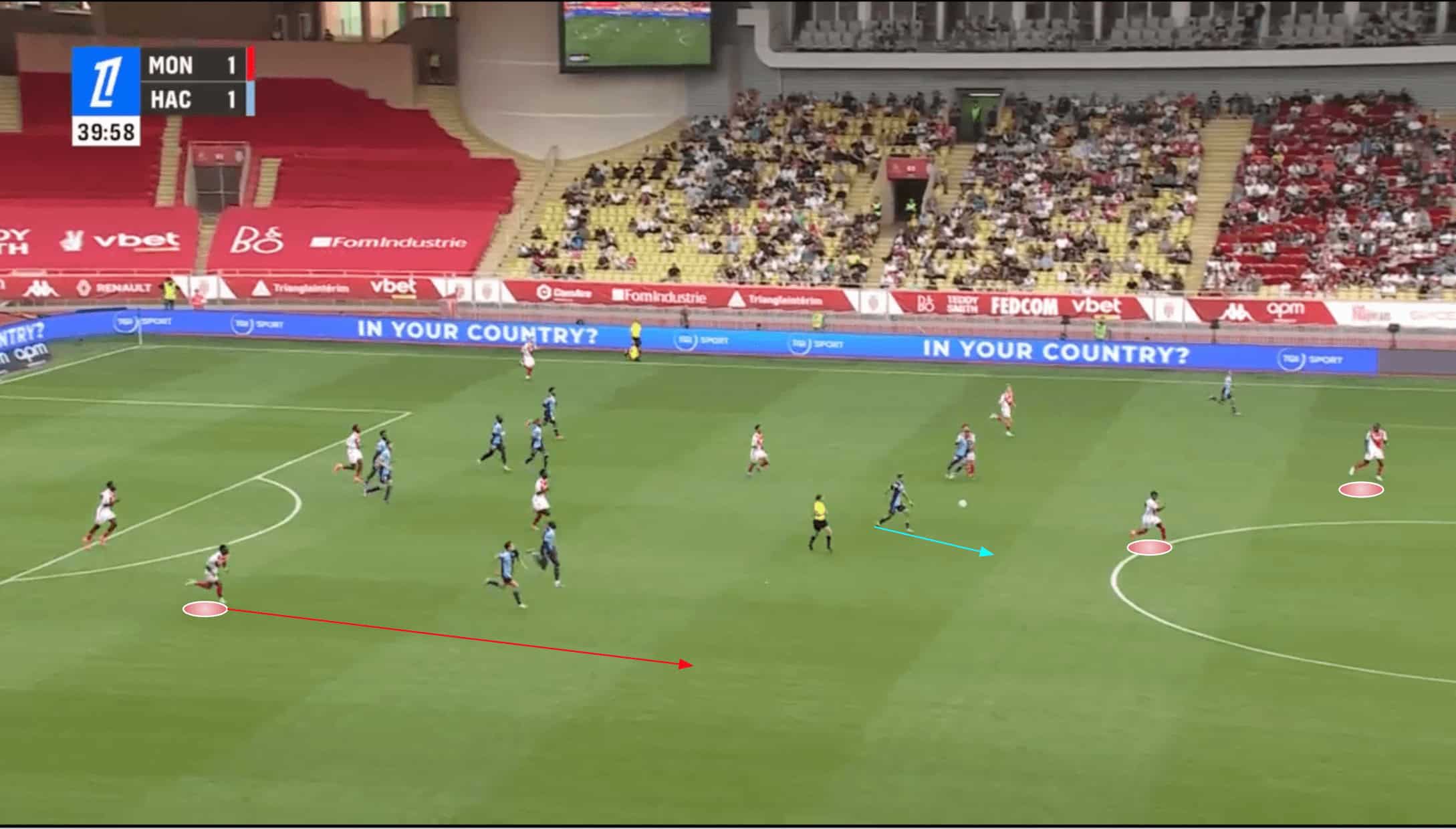
This following passage of play highlights the importance of forwards, wingers and full-backs tracking back fast for Monaco in defensive transition.
As mentioned before, their centre-backs are vulnerable in transition—they need support from those positioned higher.
Thanks to their impressive fitness levels and commitment, they often get that support when they’re able to hold up the counterattacking side for enough time.
Figure 13 shows the beginning of Le Havre’s counterattack, with Monaco’s two deepest players—the only two behind the ball in this instance—circled, along with a more advanced player who we’ll see sprint back in support as we progress into figure 14.
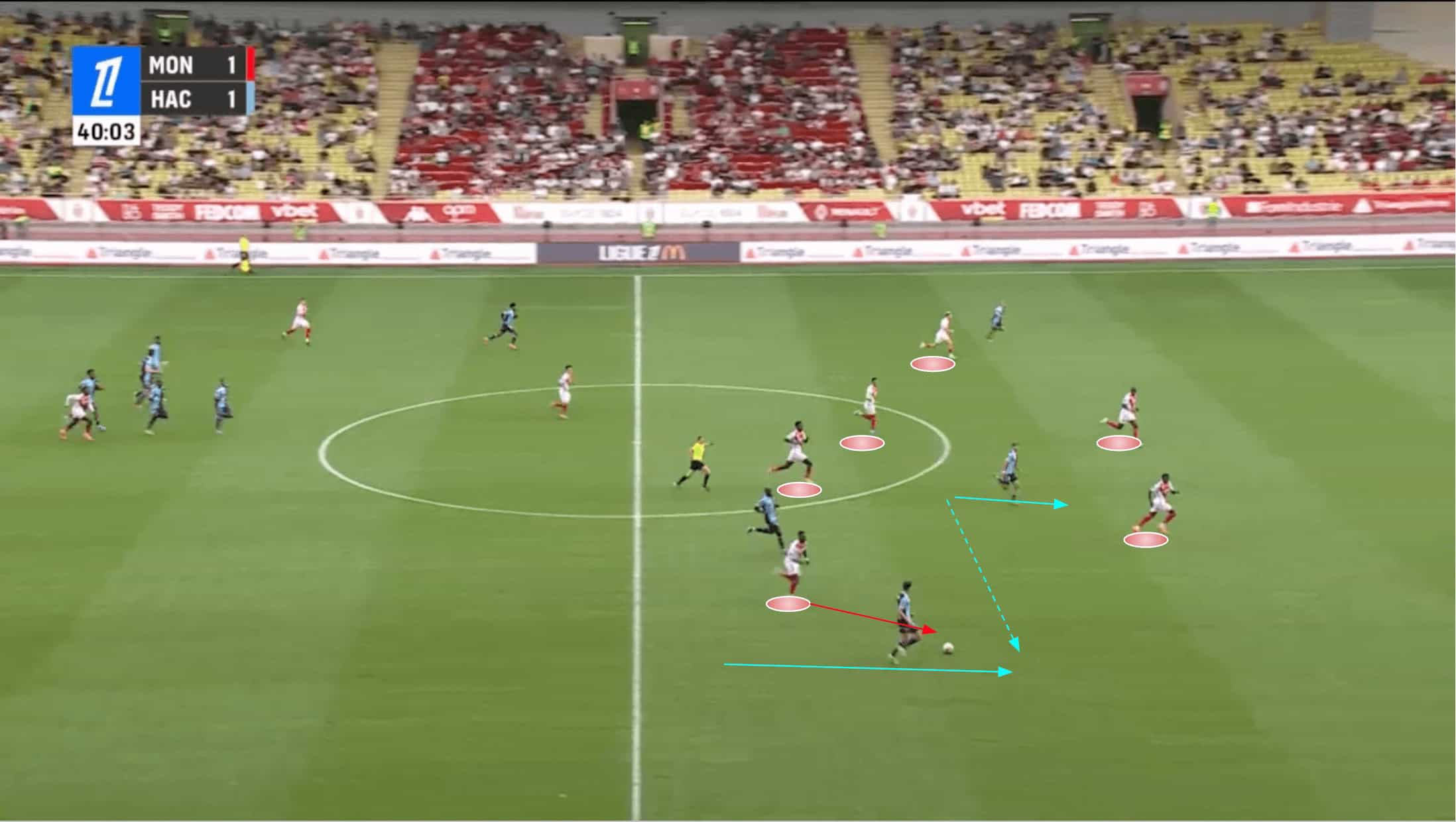
By the time Le Havre entered Monaco’s half, the player we’d circled previously on the edge of the opposition’s box had more or less caught up with the ball and could now apply pressure to the ball carrier.
Meanwhile, Monaco’s central midfielders and the ball-far full-back have also got back, crucially denying the opponent numerical superiority as they prepare to enter the final third.
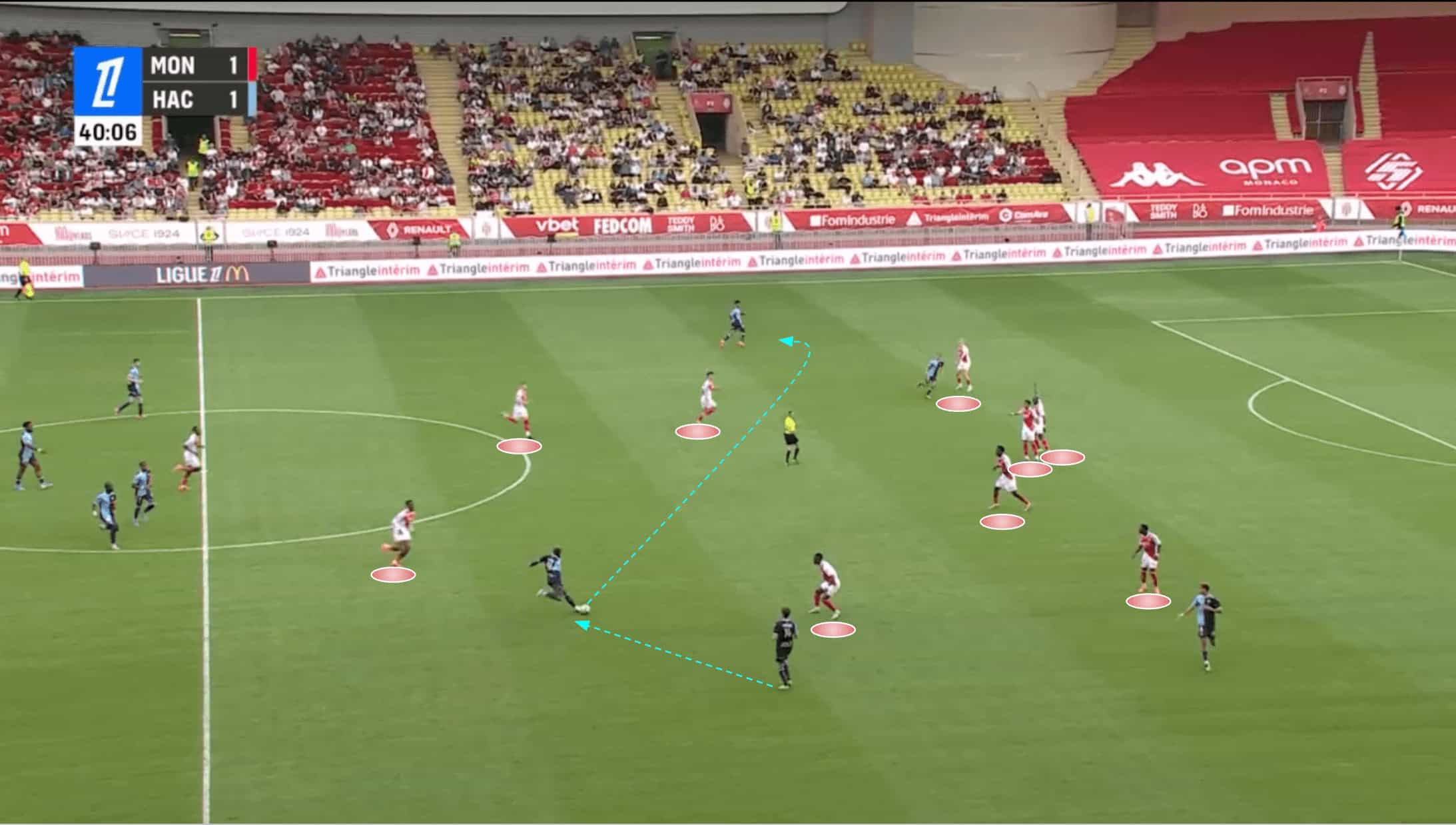
At last, eight seconds after this counterattack began in figure 13 and things looked quite bleak for Hütter’s men, Le Havre entered the final third via a switch of play to the opposite wing with all of Monaco’s outfield players in or about to enter their half.
This significantly reduced Le Havre’s threat through their fast ability to recover and reorganise themselves defensively.
This passage of play is a testament to the teamwork Hütter has instilled in his team, as well as their tactical intelligence and discipline.
Furthermore, once again, the fitness regime Les Monégasques are following deserves a mention for how quickly they got managed to track back and cover off Le Havre’s counterattacking threat here, denying them another good goalscoring opportunity.
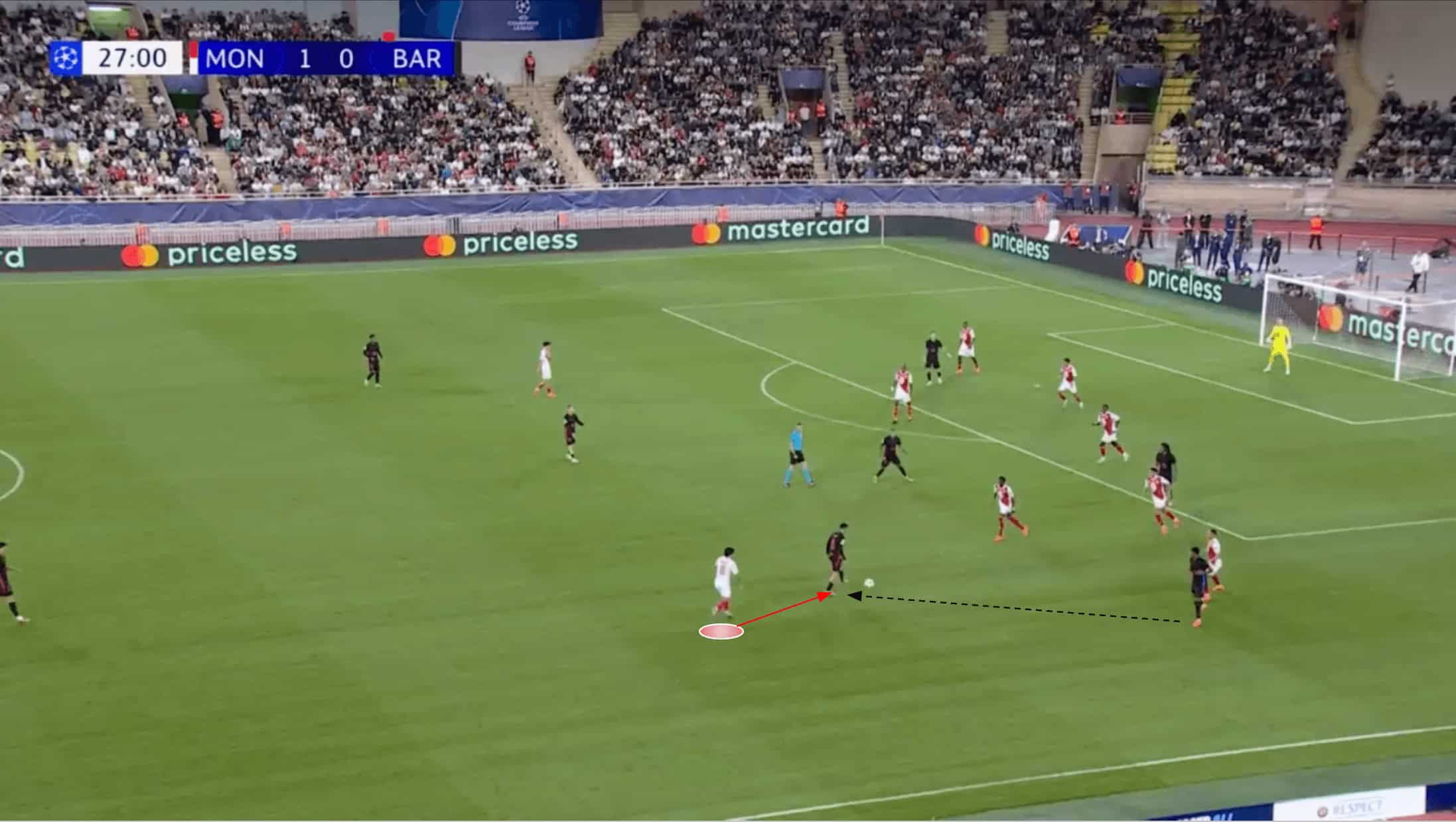
We mentioned earlier how one potential benefit of blindside pressure is to catch a player off-guard, unaware an opponent is coming from behind them.
Figure 16 shows a perfect example of this advantage, yet again from Monaco’s win over Barcelona.
Here, Pedri receives on the edge of the final third, preparing to create something for his team, unaware of the incoming pressure from behind.
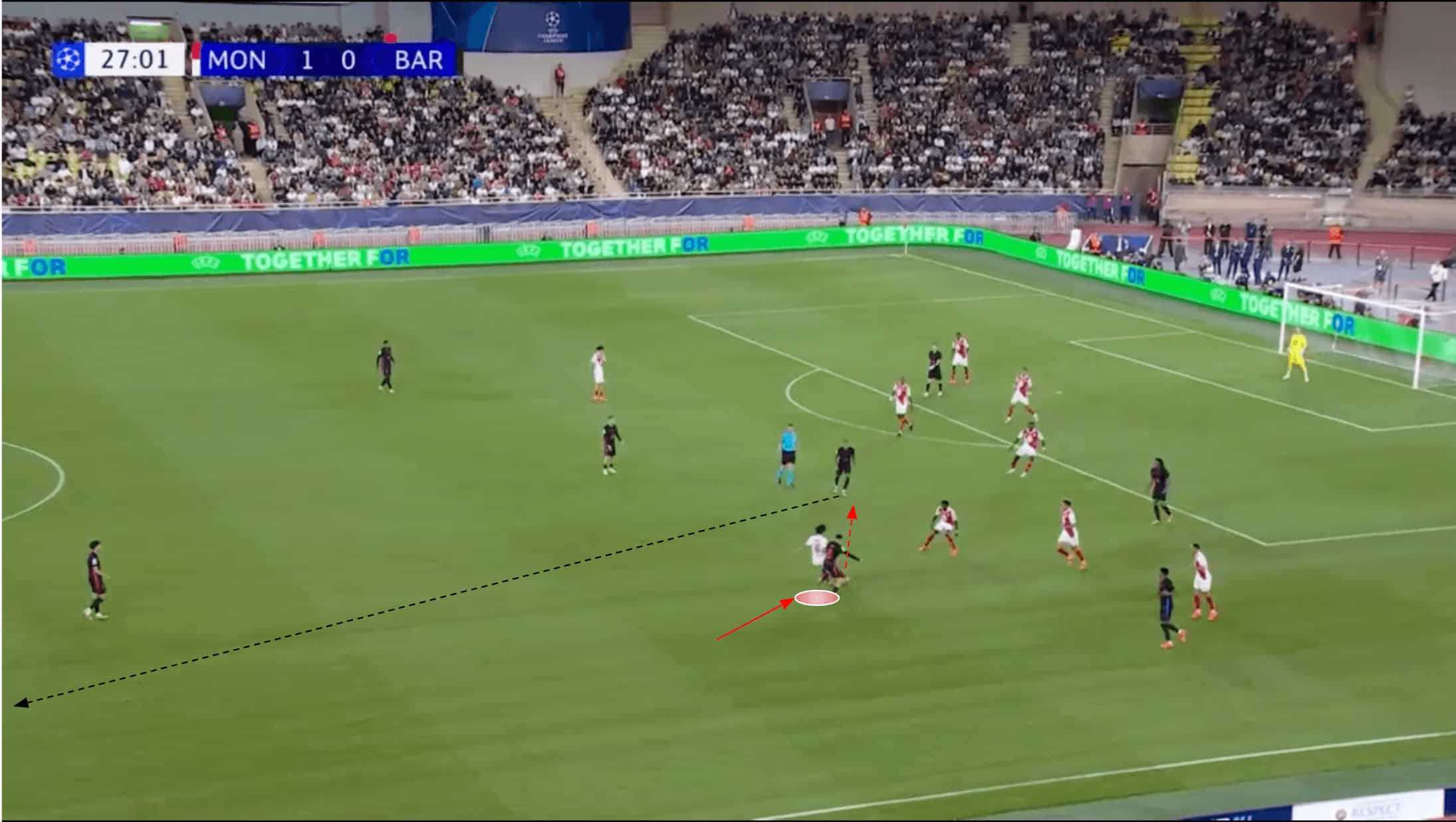
The Monaco man manages to nick the ball away from Pedri, knocking it in the direction of another Barca player, who immediately comes under intense pressure.
This leads to the ball being played all the way back to the defensive line, allowing Monaco to push up the field a bit and ultimately leaving Barca in a far worse position as a result of this blindside pressure than they originally were.
Conclusion
To conclude this tactical analysis and scout report, whether it’s in the high block, mid-block or defending deep on the edge of their own box, Monaco have demonstrated the benefits of applying blind side pressure all across the pitch thus far in 2024/25, showing how effectively applying these tactics as part of a well-organised, cohesive defensive strategy can be critical to securing results at the very top level.

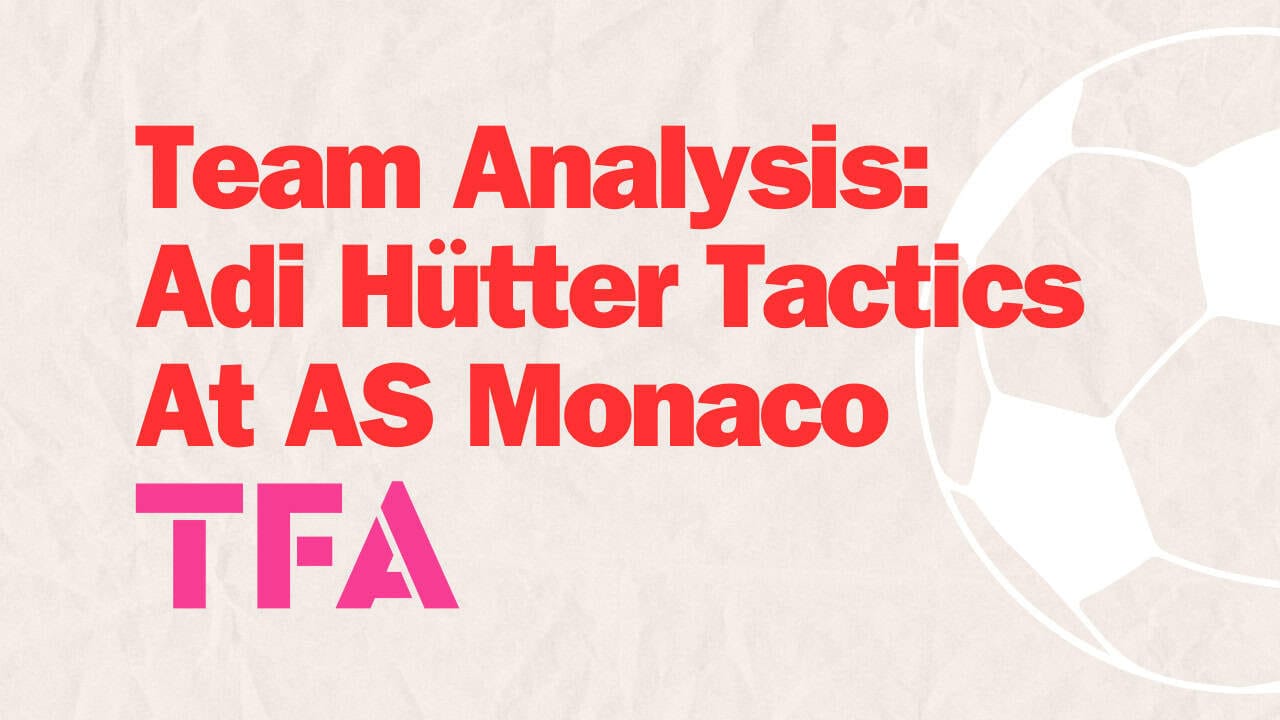



Comments